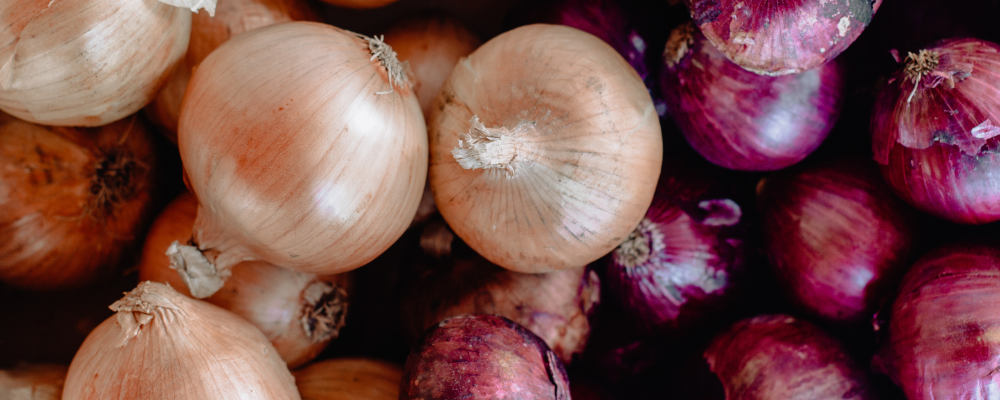
7 Types of Onions and the Best Ways to Use Them
— By Kayla Parsons, Registered Dietitian and PhD student, University of Maine Cooperative Extension
Are you a fan of all things onion? Onions are vegetables in the Allium family and include numerous varieties. Upgrade your cooking knowledge by learning about 7 common types of onions, their uses, and some of the Expanded Food & Nutrition Education Program’s (EFNEP) favorite onion-containing Mainely Dish Recipes. From yellow onions to leeks, we’ve got all of your fall dishes covered.
1. Yellow Onions
Yellow onions are a cooking staple and have a yellowish-papery skin and greenish-white bulb. Yellow onions are best when sautéed or roasted, specifically in soups, stews, sauces and roasts. These onions are high in starch, a complex carbohydrate, and maintain their structure well after cooking. With Thanksgiving right around the corner, we suggest using your yellow onions for EFNEP’s Easy Stuffing recipe. It’ll be an instant crowd pleaser!
2. Sweet Onions
Not to be confused with their yellow counterparts, sweet onions are filled with (as the name suggests) a much sweeter taste. This is due to their high simple sugar content, which contributes to their wonderful ability to caramelize easily. Common types of sweet onions include Vidaliars, Walla Wallas and Mauis. Try using sweet onions in EFNEP’s Stuffed Squash recipe to add in a hint of sweetness to your traditional fall comfort meal.
3. White Onions
White onions are pearly-white, with a somewhat translucent skin. These onions are comparatively less pungent than red onions, but can be a great substitute for yellow onions. White onions are commonly used in Mexican cuisine, salads, chutneys, or savory pie. EFNEP’s Taco Pie recipe is a great way to use up your white onions. Common types of white onions include pearl onions, Cipollini onions, and NuMex Casper onions. Looking to completely remove any stinging onion bite? Try soaking white onions in cold water for approximately 10 minutes, and then dry using a napkin to enjoy a less pungent onion.
4. Red Onions
Red onions have a deep purple skin due to anthocyanins (a type of antioxidant), with a white bulb lined with purple layers. These vibrant onions can brighten up any salad or salsa. Try our EFNEP’s Strawberry Salsa recipe for your next holiday gathering for a dynamic flavor profile featuring red onions. These onions are great for grilling or pickling, but keep in mind that their color may bleed if cooked with other items, such as potatoes. There are multiple types of red onions including Brunswick onions, Flamenco red onions and Red Beauties – all of which share the same sharp flavor.
5. Green Onions
Green onions, or scallions, contain long, slender, green tops and a small white bulb. Unlike previously discussed onions that you have to peel, all parts of green onions are edible. To unlock their flavor, wash and dice green onions prior to use. Green onions are versatile, making them great options for stir-fries, salads, omelets or as a garnish to any savory dish. If you love green onions, be sure to try EFNEP’s Egg Salad with Greek Yogurt recipe – a healthier spin on the traditional egg salad.
6. Shallots
Shallots are smaller and more bulb-shaped in nature as compared to other onions. Shallots come in various shades, but can usually be found having either brown or coppery pink skin. Shallots are unique in the fact that they grow in clusters, similar to garlic. Shallots are a jack of all trades, having an aromatic role in soups, stews, sautéing, roasting, pickling, and can even be enjoyed raw. Try EFNEP’s Winter Salad with Citrus Vinaigrette recipe as a new way to incorporate this type of onion.
7. Leeks
Similar to green onions, leeks are layered, cylindrical, green structures with a white base. All parts of a leek are edible, but most people prefer the white base of the leek for dishes because it is more tender and contains the most flavor. The darker green portion of the leek is difficult to chew, but can be used to create a vegetable stock. Leeks have a mildly sweet flavor, making them perfect for pasta dishes, risotto and soup. Keep warm this season by preparing EFNEP’s easy and delicious Carrot Leek Soup.
Resources
- Mainely Dish: Easy Stuffing
- Mainely Dish: Stuffed Squash
- Mainely Dish: Taco Pie
- Mainely Dish: Strawberry Salsa
- Mainely Dish: Egg Salad with Greek Yogurt
- Mainely Dish: Winter Salad with Citrus Vinaigrette
- Mainely Dish: Carrot Leek Soup
- Understanding the Different Types of Onions (Mississippi State University)
